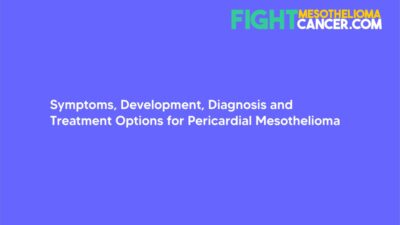Testicular mesothelioma is when malignant tumors invade the tunica vaginalis; a membranous lining that surrounds, protects & insulates the testicles.
Since the testicles are the reproductive organs of the human body, it can be very dangerous if they are damaged by cancerous tumors.
The tunica vaginalis is composed of mesothelial cells, which are cells that line the body’s serous cavities and internal organs and provide protective, non-adhesive surfaces.
Mesothelial cells also help in transporting fluids and cells across the serous cavities. The image on the left is of the tunica vaginalis composed of 2 layers; parietal (outer) layer and visceral (inner) layer.
Testicular mesothelioma is the rarest form of mesothelioma lung cancer out there with only 100 cases diagnosed this year. Since it is extremely rare, doctors do not know exactly how it is caused.
Scientists suggest 2 possible ways how testicular mesothelioma can develop;
- Patients with testicular mesothelioma have primary tumorous cells in the peritoneal membrane, while developing secondary tumors in one or both of the testicles; and
- Patients develop primary tumors in the testicles.
When testicular mesothelioma develops as a secondary tumor, it is quite possible that the source of the Cancer is a peritoneal tumor that spreads (metastasizes) to other organs and areas of the body, including the lymph nodes.
Scientists still however do not know how a primary tumor can develop directly in the testicles.
How do cells become cancerous? Once a primary tumor forms in the testicle or in the peritoneal membrane, cells go out of control and can no longer control their growth.
They divide without restraint which then causes the tunica vaginalis to thicken and grow. This eventually leads to the formation of tumors.
Symptoms of Testicular Mesothelioma
Unlike peritoneal, pleural & pericardial mesothelioma where there is a list of common symptoms, there are no defined symptoms for testicular mesothelioma.
One of the most distinguished symptom of testicular mesothelioma is appearance of testicular lumps in the testicles.
This is the only recognized sign by which doctors can diagnose testicular mesothelioma. Testicular lumps are usually found when a patient undergoes surgery or a biopsy.
Treatment Options for Testicular Mesothelioma
The most common treatment option available for testicular mesothelioma is the removal of the testicles, or a portion of it.
If the cancer has advanced very high, it may be necessary to remove the entire testicles. Other treatment options available are Chemotherapy or radiation therapy.
Radiation therapy will attempt to kill any cancerous cells in the testicles via the help of a high beam razor that directly targets tumorous cells.
Following treatment options, testicular mesothelioma has the habit of recurring after a few years. This is because it is classified as a “clinically aggressive type of cancer” and can spread & grow very fast.
dr. Maryama









